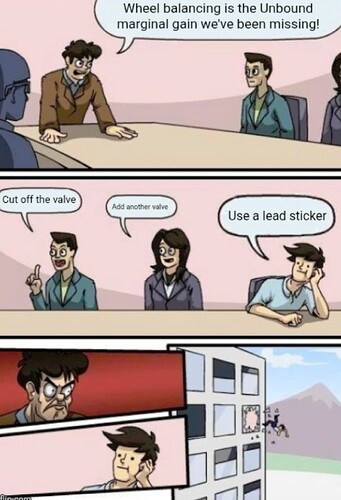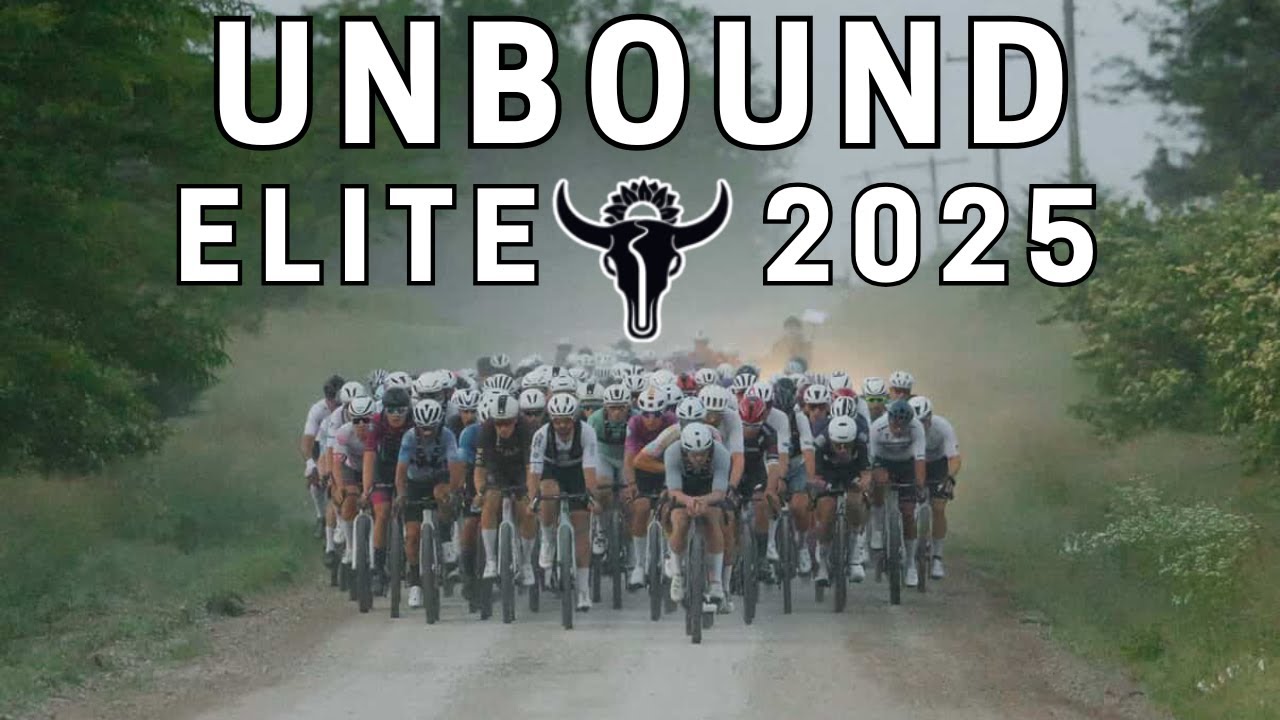Balancing out a valve by drilling the rim to insert another valve would be enough to me to get off this ride.
Keegan probably gets free wheels for this experiment.
It’s doesn’t matter if he makes money from each rim he destroys, the logic is still nonsense.
We are all just speculating. We know he or his mechanic drilled the hole. He was cagey about the rest. His friend said it was for another tube and emergency inflation.
My other thought was that a slightly inflated tube inside the tire could act like a foam insert.
@gloscherrybomb - at unbound, people bring a spare tube & various plugs for almost every tire. While some options are better than others, there’s no real indestructible tire that someone could say “nah, I won’t flat, not bringing a tube, plugs, or co2’s”.. maybe at some races, but that’d be a foolish choice at unbound.
@Torgo - the thunder burt is faster than the race king in nearly every test except one by @jkarrasch where the RK was faster by a minuscule margin on cat 3 gravel only. People are very selective running the tire on certain courses due to being so prone to flats. I had been running one up front but pulled it off for unbound for that reason.
Yeah, a lot of reasonable takes in this thread, but probably also some folks who might be lacking knowledge of the terrain. And the GCN dude talking about pulling thorns out of the tire prior to putting the tube in was pretty funny (but not surprising if you haven’t been there). A durable tire and/or insert doesn’t keep anyone from having to bring tubes, lots of sealant, and lots of plugs. Most people forego inserts because the big risk is sidewall cuts and sharp punctures, not pinch flats. And inserts are a pain when having to resort to a tube. It’s not that unbound is some apocalyptic moonscape where everyone flats, the gravel just has more sharp stuff in it and people tend to flat at a higher rate than most races. Especially the guys taking risks and rolling fast in groups. And the slices require tubes and boots more than the typical flat. I think Taylor Phinney flatted like 10 times the year he did it. And the entire Bahrain team flatted out last year from what I remember. GVA flatted twice early last year. I’d say maybe ~50/50 chance of flatting on the day for the folks racing hard in groups while most gravel races are probably well under 10% chance. A clean run at unbound is a mix of excellent prep/equipment/execution, but also some luck.
I seem to recall that GVA still got a top 10.
Yeah, he chased a bunch last year after flats and was still fighting for the podium. 30th this year and was 12th at the last aid station. Not sure if he imploded a bit or had a mechanical. I was hoping he’d be in the mix, he’s definitely one of the ex WT guys who could win it.
Tim Declerqc had the typical newbie WT pro experience with 3 flats and a DNF in the first ~40 miles. His quote afterwards - “Physically I think I was well prepared, but now I know gravel racing requires more then that.”
Oh I know, but tyres come in various levels of puncture protection and the balance is clearly all wrong with the number of punctures. I think that’s pretty evident.
It’s noted above that there are more punctures at the elite / faster level. That is true, I put a lot of that down to chasing the fastest tyre. The faster the tyre, the more prone to punctures (as a correlation). That’s just how it works.
Also, I appreciate that luck , of course, plays a part. Anyone can puncture regardless of kit choice. I just think people have got it all wrong with their risk profile.
There is a new LSRF video about unbound on their youtube channel. Laurens ten dam says they’d be given new prototype tyres three days before the race, that were supposed to be more puncture proof. But he thinks they are slow, and during the race said the whole team were slow, and he couldn’t keep up with the fast groups. If that’s true or he just had a bad day and blamed the tyres, who knows. But its probably a downside of more puncture protection, in general those tyres are slower, and if that makes you not being able to keep up in a race that’s often in groups, you’re having a bad race. Which is maybe why the risk is worth taking for those who want to stay with the groups and race fast.
(Also shows one of the downsides of being sponsored, you can’t just use the components you want.)
If I was Laurens Ten Dam (or his sponsor) I would value finishing higher than coming 35th over 48th.
I’m not though, so maybe it’s worth taking risks for these guys.
If I was Keegan, I’d trust my legs to give me a shot even with slower tyres, and consider mechanicals the number 1 risk to mitigate.
Agree that sometimes they are probably told exactly what to run. Also the tyre brands are also chasing RR now as puncture protection doesn’t seem to sell tyres.
Give a year or 2 and reliability will be a key variable at the forefront of everyone’s thoughts. Mark my words.
That’s not a new concept. Racers speak about reliability very frequently in their equipment choices. Some are, of course, limited to their sponsor options. That’s never going to change.
Tire manufacturers are also frequently touting that their new models are xx% more puncture resistant.
They may speak about it, but they are evidently not prioritising it. Look at the number of people running thunder burts. I honestly think it’s a wild gamble to run that tyre at a race like Unbound, and yet, they’re everywhere, because they’ve tested fast.
Women, who are 30-50 lbs less than men, rode thunder burts.
I didn’t see a single person riding them and I looked at a LOT of set ups while I was there. I’m not aware of any pro men that were riding them.
Do you have a few examples of people that rode them in the elite 200?
I saw one FB post about an amateur rider on TB’s and he had tons of tire issues.
Thunder burt was not a popular tire choice at unbound. And a lot of riders that normally run a MTB tire didn’t due to the mud risk, so forced onto smaller tires that are more prone to flat. Most riders are leaning toward reliability, but they have to balance it with speed to some degree. And it’s a bit of a crap shoot no matter what you run. For some riders, rolling the dice on a fast tire at the expense of reliability is a reasonable path. It you aren’t Matt Beers, you may need every watt you can get. A tire that is 75% likely to puncture might make more sense than a durable tire that is still 50% likely to puncture. Again, for some of the stuff out there, you could be running a minion downhill tire and it’s going to put a hole in it, so you’d be rolling slow all day and could still get a flat. Racing in the pack requires taking risks and you can’t always choose your line. Breakaways have lower incidents of flats, but plenty of people flat out of small breaks as well (last year, PAS dude was in the winning break and flatted late).
This guy from Bicycle station raced the elite field and flatted 3 times on the new Dubnitals, with the last flat destroying his rim at the same time. Most would consider that a durable tire/wheel setup, it’s just the nature of the course and the way it’s raced. If you are racing for a result, you have to take chances with your equipment.
I don’t disagree with a lot of that.
The dubnitals need more testing as it’s too soon to say they are reliable imo.
Interested to know what you mean by this statement. Why are smaller tyres more prone to flat?
Torbjørn Røed was 3rd and had Thunder Burt front, Terra Hardpack rear. I didn’t look any further down the top 10.
Last year, I think 1 or 2 racers were on them in the top 10 Men’s. Simen Nordahl Svendsen got 6th on them, might have been the highest placing?
Indeed, also it’s a kinda circular discussion as if they’ve flatted they are unlikely to make the top 10, so there’s less chance there has been an article on their setup.
Good point. Most are assuming they are directionally similar to the Race King, but time will tell.
Generally run at higher pressures which makes them more prone to flatting.
And my assessment of the number of Thunder Burts being run isn’t so much about knowing about that tire. It’s the fact that a relatively small number of riders ran MTB tires this year with the mud risk. I was at the start line of the elite men and women and was looking closely at tire selection as the chute was filling up. I’m not saying I saw every bike, but a good sample. The vast majority were running traditional sized gravel tires. I guess a disproportionate number of the MTB tires could have been thunder burts, but it still wouldn’t have been a big number.

